7 min read
Reengineering Parking Violation Notices: A Step Towards Clarity and Fairness
Jade Neville Feb 6, 2025 12:30:00 AM

Parking violations are an unfortunate but necessary part of urban life, ensuring that curbside regulations are followed to improve traffic, safety, and access.
While cities have worked to optimize enforcement routes, fine amounts, and collections practices, few have worked to redesign violation notices themselves. From complicated legal jargon to dense formatting, parking violations often cause frustration, confusion, and, sometimes, resentment from drivers who feel they haven’t been given a fair chance to understand or contest the ticket.
The Benefits of Notice Redesign
There’s exhaustive data redesigning parking violations and invoices will have a measurable impact on several key metrics, including payment compliance, operational efficiency, and customer satisfaction. Whether it’s through clearer presentation, visual cues that guide behavior, using plain English, or simply making the process more user-friendly, cities stand to benefit in terms of faster payments, fewer disputes, and better relationships with their customers.
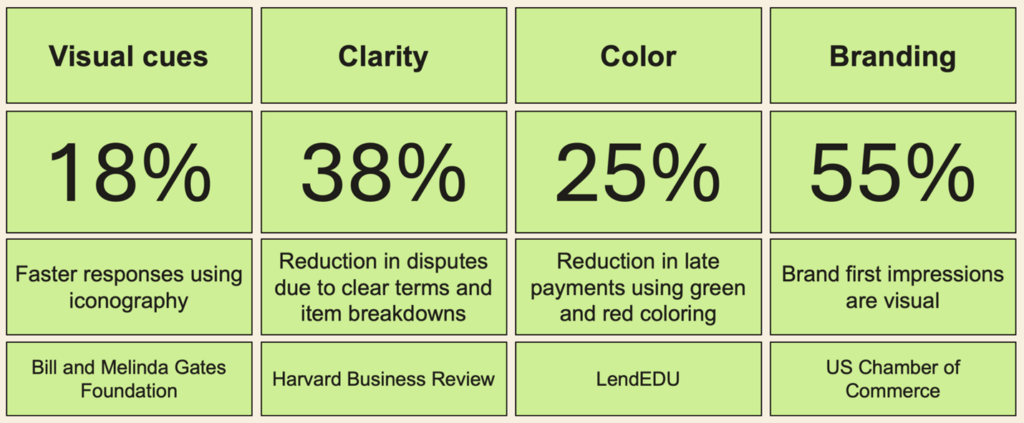
Many parking violation notices are cluttered, with information presented in a way that’s hard to follow. The date and time of the violation, the specific parking infraction, the fine amount, and the payment instructions are often buried under a mountain of legal text. This can overwhelm the recipient, especially when they’re trying to quickly determine what the violation was and how to respond.
Reengineering parking tickets and mailed notices begins with creating a simple, structured layout:
- Header: Parking Violation Notice
- Reference: The citation number
- Vehicle information: the registration number and state and the make of vehicle. Sometimes, the plate expiration, vehicle model, and color are required too
- Law violated: the municipal code section, a short description, and the fine amount
- Setting: the time, the date, the location
- Actionable steps: Clear instructions on how to pay or contest the ticket
The initial burden of demonstrating a parking violation occurred often rests with the witnessing officer or agent. They must certify the accuracy of the data. Prioritizing information on the citation makes it easier for the motorist to understand while also helping to ensure the issuer has properly captured all the necessary data evidencing the infraction.
Restructuring the Notice for Clear, Actionable Information
A common issue with parking citations and collections notices is the cluttered and often overwhelming presentation of information. Many notices bury key details, such as the amount due, the consequences of non-payment, and how to resolve the situation, under layers of legal language or unnecessary fine print. This can cause confusion and delay, as recipients struggle to figure out what steps they need to take.
In addition to providing context for the infraction, fines and collection notices should prioritize and visually highlight key details like:
- Outstanding Balance. Clearly display the total amount due, including any added penalties or interest, so that recipients can quickly understand the financial obligation. In the case of collection notice, every notice is also an opportunity to collect any additional outstanding violations owed by the motorist. Adding these tickets and the total balance owed can help incentivize payment and improve communications.
- Due Date. The deadline for payment or response should be prominently placed to avoid confusion and give the recipient a clear time frame for action.
- Actions to Take. Explicitly outline the available options for resolution, including payment instructions and how to contest the citation.
- Consequences for Non-Compliance. Provide a straightforward explanation of what will happen if the balance is not paid by the due date—such as additional fees, vehicle impoundment, registration holds, tax offsets, and/or referral to a collection agency.
Literacy, Equity, and Access
In a recent client study, we determined that motorists living in the most disadvantaged communities were much less likely to contest citations than affluent drivers. Affluent motorists were nearly 4 times more likely to contest their tickets in writing than low-income earners.
Why? It’s difficult to say, but we suspect the answer lies in the correlation between the likelihood of challenges, especially written contests, and English literacy rates, which are typically lower in economically disadvantaged communities due to economic, cultural, and systemic barriers.
Literacy skills are crucial for navigating the complexities of hearings, understanding legal instructions, meeting deadlines, and presenting evidence effectively. Addressing these disparities through notice redesign is essential for fostering public confidence and ensuring equitable outcomes.
Iconography: Simplifying Complex Information
Parking citation collections notices often contain a significant amount of information that can be hard to absorb, especially for people who are not familiar with the language or terminology. Iconography—or basic visual cues—can play a major role in improving clarity and conveying information immediately.
When communicating actions for motorists to take, citations and notices could include symbols for:
- Payment. An icon of a cash register could quickly communicate in-person payment options, while a credit card could point recipients to online payment options.
- Contesting a ticket. A judge or scale of justice can help indicate options for challenging liability.
- Legal consequences. The image of a boot or gavel may help demonstrate the potential for subsequent collections attempts.
- Questions. A question mark could indicate opportunities to speak to customer service agents.
A well-designed icon set can transform a dense legal notice into a user-friendly document. Using symbols alongside text makes the notice more accessible to a wider audience, including non-native speakers or those with lower literacy levels. Icons also help reduce ambiguity, making it clearer what needs to be done in each situation.
Plain English: Reducing Legal Jargon for Accessibility
One of the biggest hurdles with parking citation collections notices is the use of legal jargon and dense, technical language. Words like “infringement,” “liability,” or “remittance” can be alienating to recipients, especially those unfamiliar with legal or municipal terminology. While parking violation notices need to remain legally sound, there’s no reason they should be packed with complex legal language that most people can’t understand. The use of plain English should be a cornerstone of any reengineering effort.
Take a look at the following:
“Failure to remit payment by the stipulated due date may result in an assessment of additional penalties and may be subject to further legal action.”
A clearer, more straightforward version would be:
“If you don’t pay this fine by the due date, you could face additional fees or legal action.”
By stripping away unnecessary “legalese,” parking citations and collections notices become much more user-friendly, saving time deciphering what the violation means and what the ticket requires them to do.
Compare the language on the left to the revised content on the right. Which would you rather read?
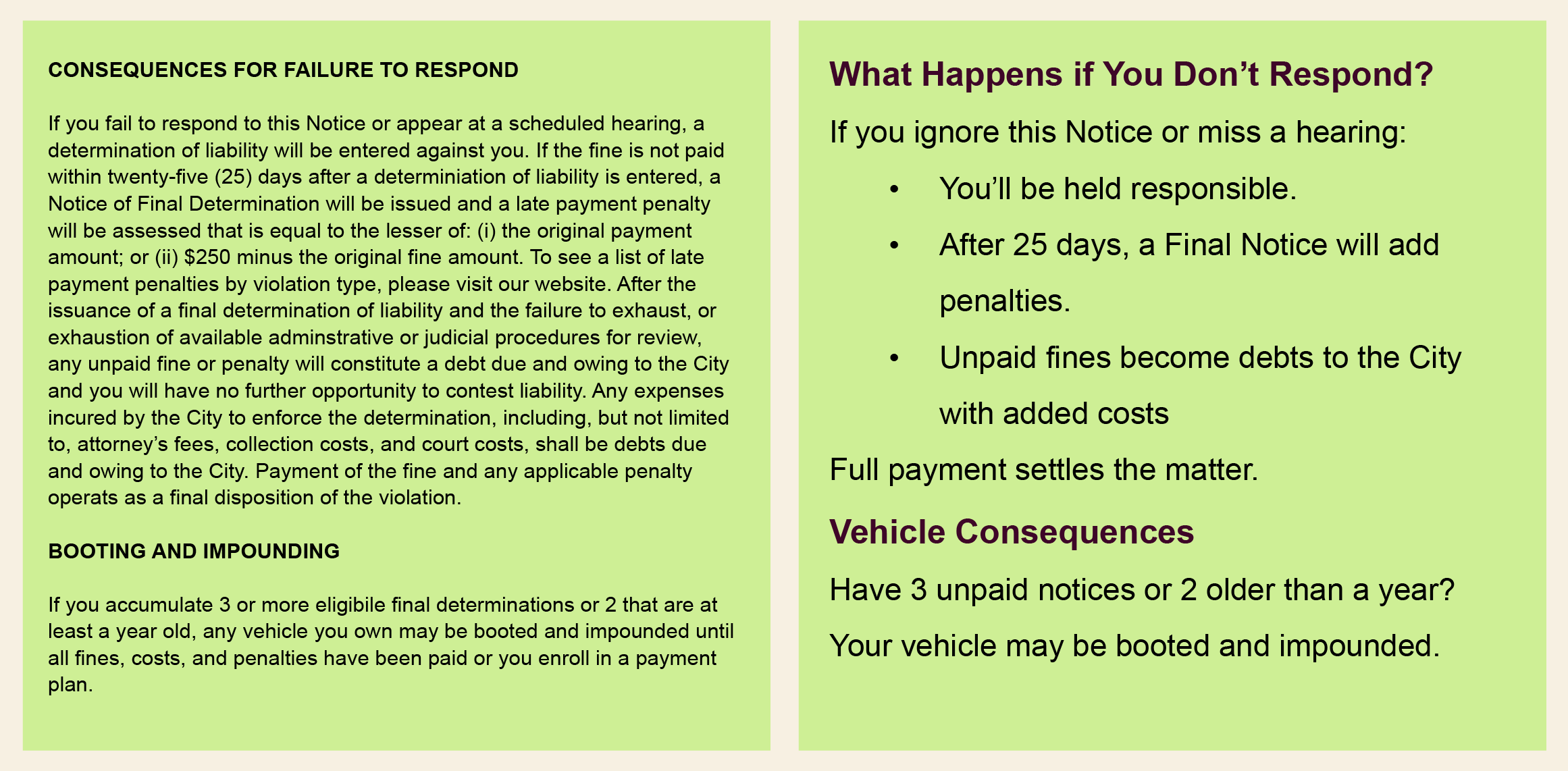
Notice Psychology
Simplifying notices also increase white space, or negative space, which plays a crucial role in the psychological effectiveness of collection notices. When used strategically, it can significantly improve readability, reduce cognitive load, and enhance emotional engagement, all of which are key when trying to get recipients to respond positively to a notice about overdue payments.
Nudge theory suggests that small design choices, like the use of white space, can subtly influence behavior. By presenting the collection notice in a non-threatening, clear, and easy-to-navigate way, you make it easier for recipients to act. Cities can further improve collections and reduce the likelihood of challenges by changing the format and style of their notices.
Typography, like other design elements, influences how people perceive and process information, and this can be harnessed to subtly guide behavior. In the context of parking violations and collection notices, fonts can help increase readability, convey urgency or professionalism, and even elicit a desired response like making a payment. A comparison of recommended changes follows.
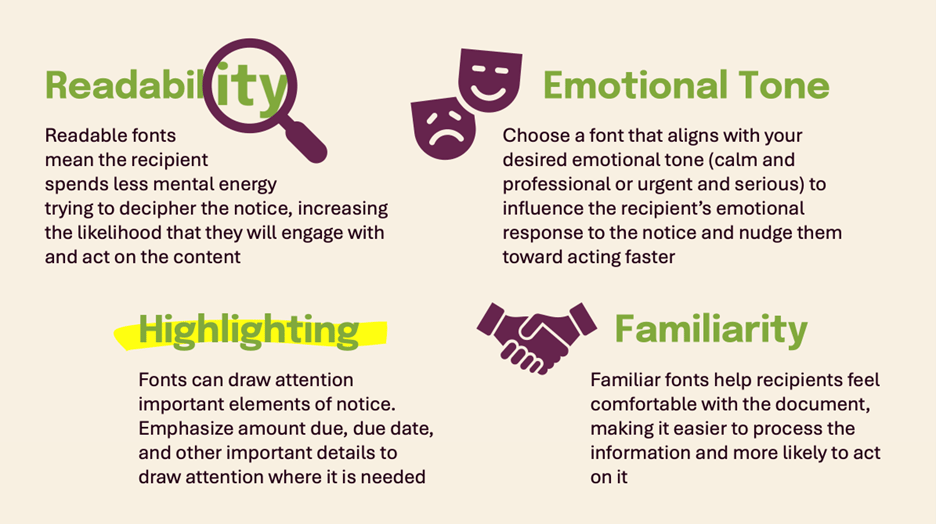
Color also plays a significant role in influencing behavior and emotions, and it can be a powerful tool when it comes to nudge theory—particularly when trying to collect parking debt. The psychological impact of color can subtly guide the recipient’s perception, reduce negative emotions, and increase the likelihood of timely payment.
Red, for example, is associated with urgency, attention, and action. Red creates a sense of immediacy and importance, which may help push the recipient to act quickly. That said, red should be used sparingly as it is also perceived as being aggressive and alarming. Overused might stress the motorist, causing avoidance. A good strategic use of red would be to highlight amounts due, due dates, and looming penalties.
There are multiple color principles that, when combined with font strategies, can create more effective notices. Typography and design can subtly nudge ticketed motorists toward action.
Personalize It
Personalization can make notices more relevant, engaging, and persuasive. They also increase response rates. There are several ways to personalizing parking violation notices, including:
- Local payment options and locations, including convenience stores, utility cashiers, and payment kiosks
- Payment plans and forgiveness programs for motorists in underserved communities
The City of Chicago excels at personalizing parking violation issuance. During the citation process, the parking enforcement officer’s handheld software verifies the motorist’s status. If they are eligible for a forgiveness program or payment plan, a secondary “ticket” prints providing details and links to participate. The platform also verifies whether the ticketed vehicle is on the boot list. If so, boot eligible motorists also receive a second form noting they could have been booted today and stressing the need to resolve their tickets quickly. Since implementation, 47% of motorists receiving a boot warning at time of ticketing immediately comply. Examples of those notices appear below.
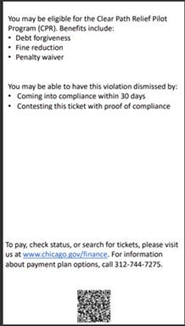
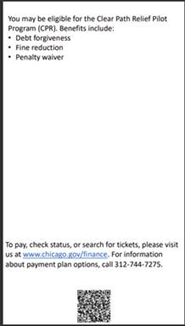
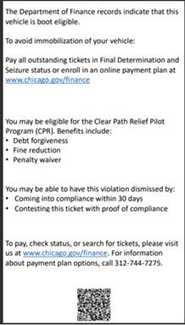
Consistency and Standardization Across Notices
Consistency is key when it comes to designing an effective system for parking tickets. If cities and municipalities adopt notice reengineering practices, it’s essential that they standardize the layout, utilize a branded iconography, and communicate using plain English across all parking violation notices. This will help create a sense of familiarity for drivers, which can reduce confusion when they receive tickets in different locations.
Over time, standardization reduces ambiguity and ensures that people will become more familiar with the steps they need to follow when dealing with a parking citation. When drivers receive notices with the same layout and language, they’ll quickly understand the format and what information to look for.
Adding Value: Providing Helpful Resources
In addition to simplifying the format and language, parking citation collections notices should provide clear guidance on how to resolve the issue. Often, recipients may not know how to dispute a citation, how to make a payment, or what to do if they think the ticket was issued in error. Providing these resources directly on the notice, such as:
- Links to online payment portals
- Clear instructions on how to contest the ticket
- Phone numbers or customer service options for questions
- Addresses for in-person payments or disputes
- Other opportunities to avoid penalties and consequences
By including brief instructions or even a QR code that leads to an FAQ page or an online dispute platform, cities can make it easier for individuals to resolve their issues efficiently.
Conclusion: Clear, Actionable Communication Benefits Everyone
Reengineering parking citation collections notices is not just about improving aesthetics—it’s about ensuring that the recipients fully understand their responsibilities, opportunities, and the consequences of non-payment. By restructuring the notice format, incorporating intuitive iconography, and using plain English, municipalities can make these notices easier to understand and act upon. The goal is to reduce confusion, prevent errors, and ultimately improve compliance, ensuring that parking regulations are enforced in a way that is both fair and transparent.
As municipalities adopt these design principles, parking tickets will be more than just a method of enforcement—they can become a tool for clear communication, reducing the likelihood of mistakes and misunderstandings. Ultimately, this will contribute to improved revenues, increased deterrence, customer satisfaction, and more efficient cities, where rules are followed because they are understood, not because they are enforced through opaque and frustrating processes.
Transform Your Parking Violation & Collection Notices Today
Are your parking violation and collection notices effectively encouraging timely payments, or are they being ignored or misunderstood? By redesigning your notices, you can:
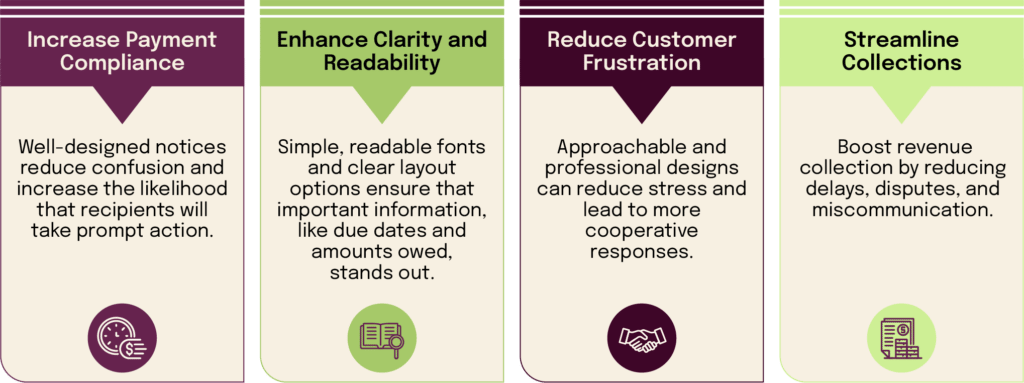
Let us help you create more effective, efficient, and customer-friendly notices. Whether you’re looking to improve readability, convey urgency, or make payment instructions clearer, Trellint can guide you through the redesign process to achieve your goals.
Contact us todayand discover how small design changes can make a big difference in improving compliance.




.png)